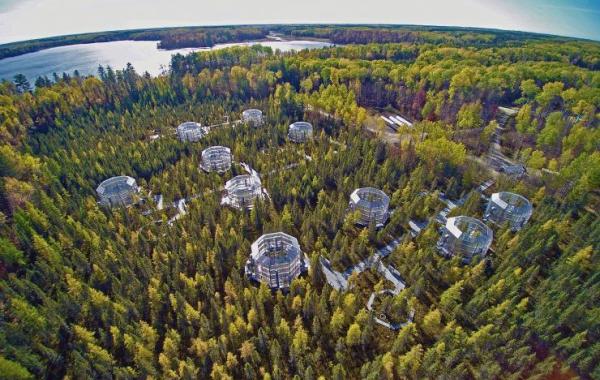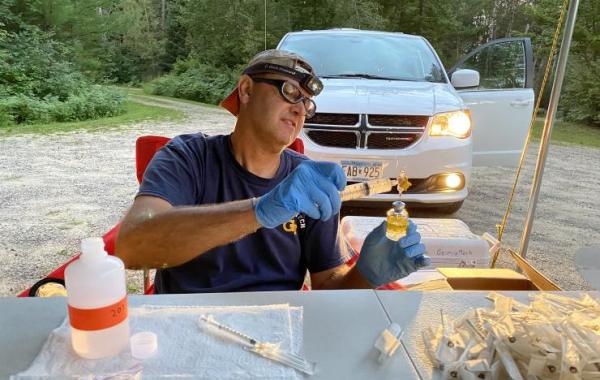Temperate Glimpse Into a Warming World

For the past six years, multidisciplinary researchers from across the world have been probing northern Minnesota peat bogs in an unprecedented, long-range study of climate change supported by the U.S. Department of Energy. They set out to answer complex questions, including one big one – will future warming somehow release 10,000 years of accumulated carbon from peatlands that store a large portion of earth’s terrestrial carbon?
So the Oak Ridge National Laboratory (ORNL) partnered with the USDA Forest Service to develop a one-of-its-kind field lab in the Marcel Experimental Forest, where below and above ground heating elements are gradually warming the bog in greenhouse-like enclosures big enough to include trees. The enclosures are roofless so that rain and snow can get in.
It’s called the SPRUCE (Spruce and Peatland Responses Under Changing Environments) experiment, and it was designed as a window into what would happen to peat bogs in a warmer world. A recent study, headed by Georgia Institute of Technology microbiologist Joel Kostka and published June 14 in the journal PNAS, provides a sobering outlook.
“The real concern and one of the major conclusions of this paper is that the ecosystem we’re studying is becoming more methanogenic,” said Kostka, professor and associate chair of research in the School of Biological Sciences, who holds a joint appointment in the School of Earth and Atmospheric Sciences and focuses on microbial ecology. “In other words, the warmed bog is enhancing the rate of methane production faster than that for carbon dioxide. This is what we think is going to happen in a warming world, based on our results.”
Testy Little Process
Methanogens are microbes that produce methane, a harmful greenhouse gas that traps up to 30 times more heat than carbon dioxide. Warming the peatland, the researchers found, basically creates a methane production line.
“This occurs because the plant community changes in response to warmer temperatures – mosses decrease and vascular plants increase,” said the paper’s lead author, Rachel Wilson, a researcher with Florida State University’s Department of Earth, Ocean, and Atmospheric Science, where she works in the lab of professor Jeff Chanton, co-author and co-principal investigator of the study.
The process forms a complete cycle: Vascular plants – shrubs and grass-like plants – produce more simple sugars, which are broken down by fermentative bacteria, and the breakdown products then fuel methane-producing microbes use to produce more methane.
While peatlands comprise just 3 percent of the Earth’s landmass, they store about one-third of the planet’s soil carbon. The thinking goes, as global temperatures rise, microbes could break into the carbon bank and the resulting decomposition of the ancient, combustible plant biomass would lead to increased levels of carbon dioxide and methane being released into the atmosphere, accelerating climate change.
“Methane is a stronger greenhouse gas than carbon dioxide,” said Wilson. “Warming the climate stimulates methane production, which will contribute to more warming in a positive feedback loop.”
It’s a scenario that Chanton called, “a critical ecosystem shift. Peat soils that have been stable for thousands of years are giving up the ghost, so to speak. It’s a testy little process.”
Delayed Response
That unpleasant outcome is being delayed somewhat by the extreme conditions found in many peat bogs around the world, including at the SPRUCE experiment site.
“Although most peatlands are in northern regions undergoing some of the most rapid warming on the planet, we’re talking about generally cold, acidic soils where there’s no oxygen,” Kostka noted. “Methanogens grow really slowly under these extreme conditions. We do see their activity increasing with warming, but they’re not yet growing that fast.”
He has a good idea of what could happen, though. Several years ago, Kostka took soil samples from the Minnesota site and tested them in his lab at Georgia Tech, exaggerating the temperature to a much greater degree than would be possible in a large-scale experiment like SPRUCE.
Raising the temperature by 20 degrees Celsius, about twice the temperature range used in the field experiment, “we saw huge increases in methane and large changes in the microbes that break down soil carbon into greenhouse gases,” he said.
It's a sped-up version of what they’re seeing in the field where the research team, Kostka explained, “and it is just beginning to scratch the surface of the changes we’re seeing in this ecosystem.”
Next Chapter
The SPRUCE site experiment involves two kinds of treatment, warming and also elevated carbon dioxide. The warming treatment started in 2014. All of the data sets for the PNAS paper are from 2016. The elevated carbon dioxide treatment began in the final days of data collection, so it wasn’t particularly relevant for this study. “Going forward, we’re thinking the effects of elevated carbon dioxide will be one potential future story to tell,” Kostka said. “This is a long-term experiment and many of these large scale climate change field experiments do not observe substantial changes to microbial communities until 10 years after they start.”
Ultimately, SPRUCE experimental activity is designed and intended to develop a quantitative mechanistic understanding of carbon cycling processes, according to Paul Hanson, the Oak Ridge National Laboratory scientist leading the long-range project as principal investigator.
“SPRUCE provides experimental insights for a broad range of plausible future warming conditions for an established peatland ecosystem, combined with or without elevated carbon dioxide,” Hanson said.
So far, the evidence is pointing to a grim possibility: Warming enhances the production of carbon substrates from plants, stimulating microbial activity and greenhouse gas production, possibly leading to amplified climate-peatland feedbacks. Think, gasoline on a fire.
“That would be the worst case scenario,” Kostka said. “We don’t really know yet how plants and microbes will exchange carbon and nutrients in a warmer world. Will that carbon be locked up by the plants and stored in the soil? Will it be respired by microbes and released as a gas?
We are just beginning to see major changes in the microbes and plants at the SPRUCE peatland. Although the first few years of the experiment indicate that a lot more methane will be released to the atmosphere, we will be looking to see if these changes are sustained over the long term.”
CITATIONS: Rachel M. Wilson, Malak M. Tfaily, Max Kolton, Eric Johnston, Caitlin Petro, Cassandra A. Zalman, Paul J. Hanson, Heino M. Heyman, Jennifer E. Kyle, David W. Hoyt, Elizabeth K. Eder, Samuel O. Purvine, Randy K. Kolka, Stephen D. Sebestyen, Natalie A. Griffiths, Christopher W. Schadt, Jason K. Keller, Scott D. Bridgham, and Jeffrey P. Chanton, and Joel E. Kostka. “Soil metabolome response to whole ecosystem warming at the Spruce and Peatland Responses Under Changing Environments experiment” (PNAS, June 2021) https://doi.org/10.1073/pnas.2004192118
AERIAL PHOTO: Hanson, P.J., M.B. Krassovski, and L.A. Hook. 2020. SPRUCE S1 Bog and SPRUCE Experiment Aerial Photographs. Oak Ridge National Laboratory, TES SFA, U.S. Department of Energy, Oak Ridge, Tennessee, U.S.A. https://doi.org/10.3334/CDIAC/spruce.012 (UAV image number 0050 collected on October 4, 2020).
RELATED LINKS:
“Soil metabolome response to whole ecosystem warming at the Spruce and Peatland Responses Under Changing Environments experiment”
Joel Kostka – Microbial Ecology
“Shaking a Sleeping Bog Monster” (Research Horizons)
NSF Supports Research on the Microbes in Peat Moss
ScienceMatters Podcast: Digging Up Climate Clues in Peat Moss

